Difference between revisions of "Workshop"
(→Software Requirements) |
|||
| Line 1: | Line 1: | ||
| − | This workshop will guide you through setting up and using the MAGEEC energy measurement boards. | + | The MAGEEC project has designed a board for high frequency measurement of energy usage. This workshop will guide you through setting up and using the MAGEEC energy measurement boards. |
| + | |||
| + | At its simplest, the power measurement shield works by sampling the voltage drop across a resistor wire inline with a power supply. It is implemented as a shield for a ST Microelectronics STM32F4 Discovery board. The STM32F4 is used to process the raw data and pass it out over USB. The shield can measure up to three external targets simultaneously, as well as measuring its own energy usage. | ||
| + | |||
| + | The hardware is a fully open design by Dr Simon Hollis of Bristol University. It may be downloaded from GitHub: https://github.com/mageec/powersense-shield. | ||
| + | |||
| + | [[File:Energymonitor1.jpg|700px|frameless|Image of the Energy Monitor]] | ||
| + | |||
==Software Requirements== | ==Software Requirements== | ||
Revision as of 10:51, 12 January 2014
The MAGEEC project has designed a board for high frequency measurement of energy usage. This workshop will guide you through setting up and using the MAGEEC energy measurement boards.
At its simplest, the power measurement shield works by sampling the voltage drop across a resistor wire inline with a power supply. It is implemented as a shield for a ST Microelectronics STM32F4 Discovery board. The STM32F4 is used to process the raw data and pass it out over USB. The shield can measure up to three external targets simultaneously, as well as measuring its own energy usage.
The hardware is a fully open design by Dr Simon Hollis of Bristol University. It may be downloaded from GitHub: https://github.com/mageec/powersense-shield.
Contents
Software Requirements
http://mageec.org/w/index.php?title=Workshop&action=edit§ion=1 Install packages required to build the firmware for the energy monitor board
add-apt-repository ppa:terry.guo/gcc-arm-embedded
If on Ubuntu 13.10, the following is required
sed -i 's/saucy/raring/' /etc/apt/sources.list.d/terry_guo-gcc-arm-embedded-saucy.list
Install an ARM toolchain
sudo apt-get install gcc-arm-none-eabi
If the target board is a shrimping kit / arduino / AVR
sudo apt-get install gcc-avr gdb-avr avr-libc avrdude arduino
Install other libraries needed
sudo apt-get install git python-numpy python-scipy build-essential python-pip sudo pip install pyusb
Connecting the hardware
TODO pictures and diagrams of the hardware connections
Software setup
TODO library prerequisites
TODO flashing the energy monitor
Using the software
TODO command line utility to read power data
TODO python scripting
Challenges
This section gives some examples for you to try out with the energy measurement kit.
Persistence of Vision
This uses one of the shrimping.it persistence of vision kits.
TODO energy required for different messages TODO compiler options exploration TODO interrupt driven version
Sorting
Try different sorting algorithms. Which is most energy efficient?
BEEBS
We use the a benchmark suite called BEEBS for our research. Try running some of these benchmarks on different hardware targets, with different clock speeds. Which takes the least energy?
